Boosting Your Health by Engaging All Three Vagal Regions
Written on
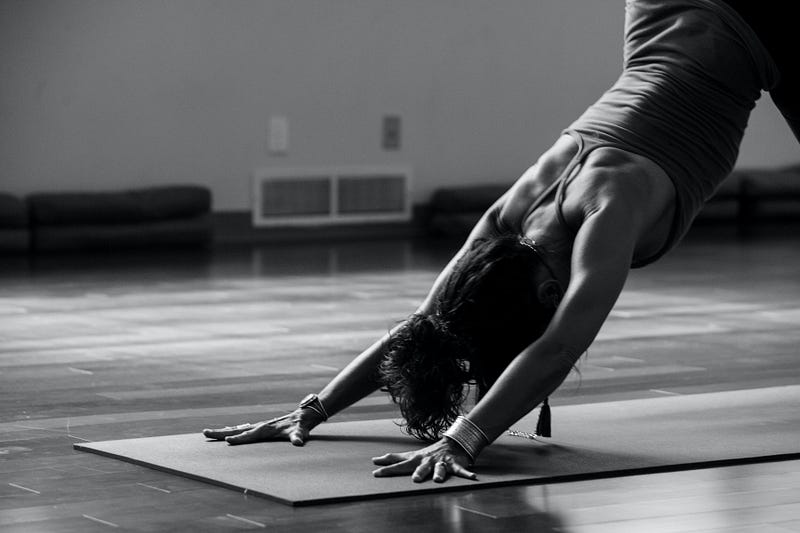
The vagus nerve comprises a significant part of the parasympathetic nervous system, playing a crucial role in our ability to relax and digest. When this nerve is under pressure, it can lead to various health issues, from digestive problems and mood disturbances to cardiovascular concerns and autoimmune disorders.
Fortunately, incorporating daily exercises can enhance its function, accommodating everyone’s needs.
This nerve, the longest in the body, extends from the brainstem to various regions, including the tongue, throat, neck, heart, lungs, abdomen, and gut.
Thus, it can be categorized into three specific areas: - The upper vagus — encompassing the neck, face, jaw, and throat - The middle vagus — involving the diaphragm, rib cage, and lungs - The lower vagus — situated within the abdominal organs like the kidneys and spleen.
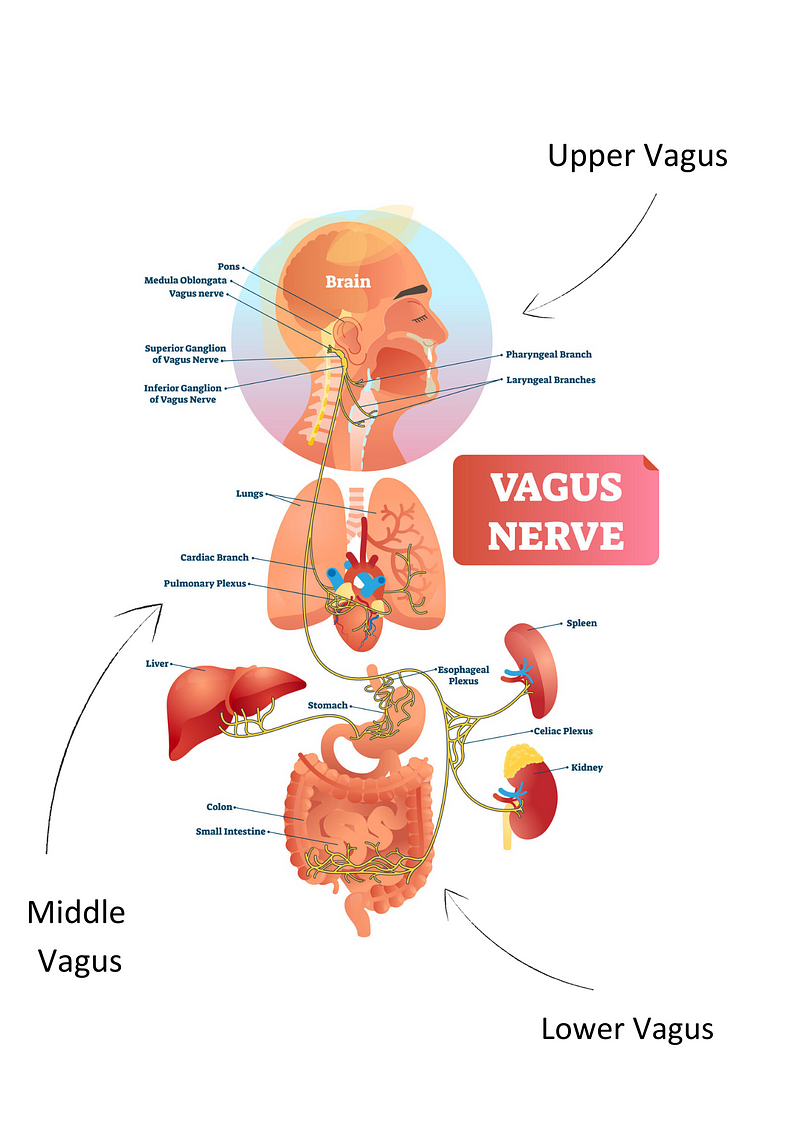
Let’s begin with the upper region and progressively move towards the abdomen. There are numerous exercises available, ranging from gentle massages that alleviate tension and inflammation to breathing techniques that enhance oxygen flow to tissues, and specific yoga postures that mend muscle tissue while lowering stress levels.
Table of Contents
- Working the Upper Vagus
- Exercise #1: Eye Pressure Technique
- Exercise #2: Soft Eyes Technique
- Exercise #3: Jaw Massage or Tapping
- Exercise #4: Chanting, Humming, or Singing
- Working the Middle Vagus
- Working the Lower Vagus
- Exercise 1: Child’s Pose (Balasana)
- Exercise 2: Reclining Cobbler’s Pose (Supta Baddha Konasana)
- Exercise 3: Happy Baby Pose (Ananda Balasana)
- Exercise 4: Half Bridge Pose (Ardha Setu Bandhasana)
- Exercise 5: Abdominal Massage
- Additional Considerations
- Summary
Working the Upper Vagus
The upper vagus focuses on the neck, face, jaw, and throat, offering various exercises and daily practices. Here are four of my favorites.
Exercise #1: Eye Pressure Technique
Gently applying pressure to the eyes activates the oculocardiac reflex, resulting in a decrease in heart rate and a calming effect on the nervous system.
You can achieve this by using a light eye mask or simply placing your palms over your eyes. I often practice this for 1–2 minutes every hour when working on a computer, or at the end of a yoga session during savasana. This practice has been shown to calm the vagus nerve and aid in muscle recovery.
Andrew Huberman refers to these as non-sleep deep rest (NSDR) exercises, which he has been practicing for a decade.
> “A 10–20 minute nap or NSDR (Non-Sleep-Deep-Rest) have both been shown to replenish physical energy & increase cognitive function. NSDR also enhances striatal dopamine & improves self-directed relaxation, which ultimately promotes better sleep.” — Andrew Huberman
To practice: - Lie on your back with legs slightly wider than hip-width. - Let your feet drop to the sides. - Position your arms alongside your body, palms facing up. - Use an eye mask or your palms over your eyes. - Relax your face, tongue, and eyes. - Breathe slowly and deeply, focusing on lengthening your exhales. - Stay in this position for 5–10 minutes. - If you feel lower back discomfort, place a cushion under your knees.
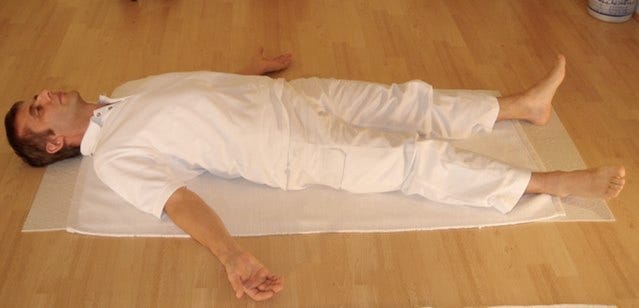
Exercise #2: Soft Eyes Technique
This practice is another favorite of mine.
Our eyes can reflect our mental state, with focused eyes indicating alertness, while soft, open eyes signify relaxation. By fostering “soft eyes,” we can encourage a more relaxed nervous system.
This technique is effective for reducing stress, alleviating anxiety, and promoting bodily relaxation.
To practice: - Sit comfortably and allow your body to unwind. - Focus your gaze on a distant object. - Begin to notice your peripheral vision while maintaining your gaze. - Expand your awareness to your surroundings without moving your eyes. - Allow your eyes to soften as you continue to breathe. - Remain in this state for as long as feels comfortable.
Exercise #3: Jaw Massage or Tapping
Massaging the jaw can enhance vagal tone since the vagus nerve traverses this area. I enjoy making large circular motions around the muscle-heavy part of my jaw and lightly tapping the bony areas.
Feel free to explore what feels right for your body and trust your instincts.
Exercise #4: Chanting, Humming, or Singing
The throat muscles are linked to the vagus nerve, making singing, chanting, or humming excellent methods to stimulate it.
Humming also generates nitric oxide, which enhances blood circulation, reduces inflammation, and supports heart health. Moreover, it has various beneficial properties against viruses and bacteria.
Another enjoyable way to activate the vagus nerve is by gargling water or even inducing a gag reflex.
Working the Middle Vagus
The middle vagus involves the diaphragm, rib cage, and lungs. Thus, breathing exercises are essential.
There are countless breathing techniques available; some quicken the breath while others slow it down. For stimulating the vagus nerve, slower breathing is typically more effective.
One of my go-to practices is rhythmic breathing.
To practice: 1. Inhale through your nose for 4 seconds. 2. Exhale through your nose or mouth for 4 seconds. 3. Avoid pausing at the top of the inhale or the bottom of the exhale. 4. Continue for 5 minutes or 40 breaths. 5. Finish by holding your breath as long as is comfortable. 6. Transition back to normal breathing.
If four seconds feels lengthy, adjust to two or three seconds as needed until you feel more relaxed, then gradually extend your breath.
As long as your rhythm is consistent and effortless, any pattern works. Your heart and nervous system will intuitively respond and achieve coherence.
Working the Lower Vagus
Now, we shift to the lower vagus, or abdominal area, which naturally lends itself to movement-based exercises, particularly yoga.
> “Yoga stimulates different nerves in your body, especially the vagus nerve that carries information from the brain to most of the body’s major organs, slowing everything down and allowing self-regulation.” — Deepak Chopra
Before engaging in any exercises, it’s wise to start gently and progress gradually. Below is a simple sequence to follow.
Exercise 1: Child’s Pose (Balasana)
This pose fosters a sense of calm and grounding while activating the vagus nerve.
To practice: - Kneel on your mat, either with knees together or apart. - Gradually lower your torso towards the mat, resting your forehead on it or on a cushion. - Position your arms comfortably behind you or extended in front. - Remain in this pose for 3–10 minutes.
If your knees feel uncomfortable, consider widening them for a more hip-opening variation.
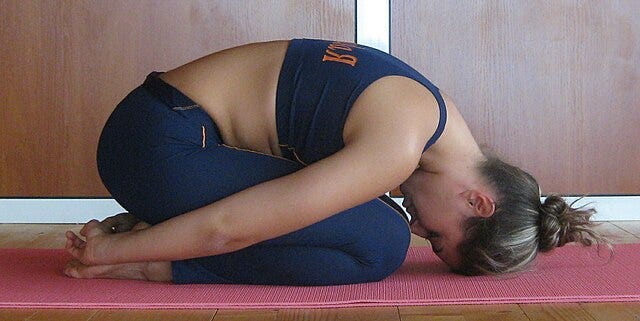
Exercise 2: Reclining Cobbler’s Pose (Supta Baddha Konasana)
This pose is excellent for connecting with your breath and activating the parasympathetic nervous system.
To practice: - Lie on your back, bringing the soles of your feet together and allowing your knees to relax outward. - Place your hands by your sides, palms facing up, or on your body wherever comfortable. - Breathe gently, focusing on lengthening your exhales. - Stay here for 3–10 minutes.
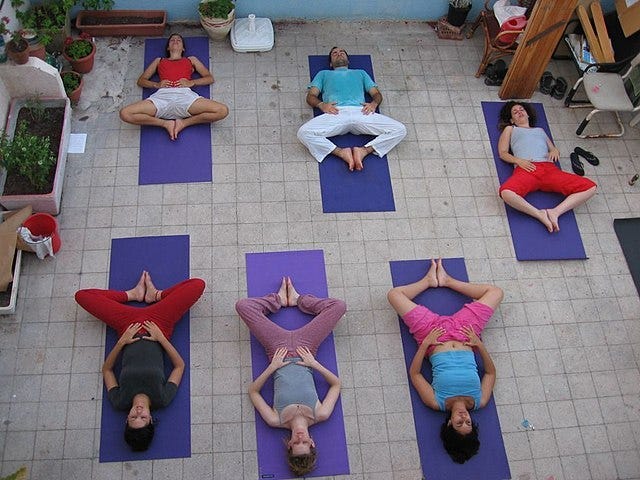
Exercise 3: Happy Baby Pose (Ananda Balasana)
This posture reconnects you with your inner child, gently rocks the spine, and aids digestion.
To practice: - Lying down, extend your legs upward and grasp the outer edges of your feet, drawing your knees toward your armpits. - Stabilize your spine and breathe into the pose. - Hold still or rock gently side to side or front to back for 10 breaths.
> For additional lower back support, place a cushion under your hips for elevation.
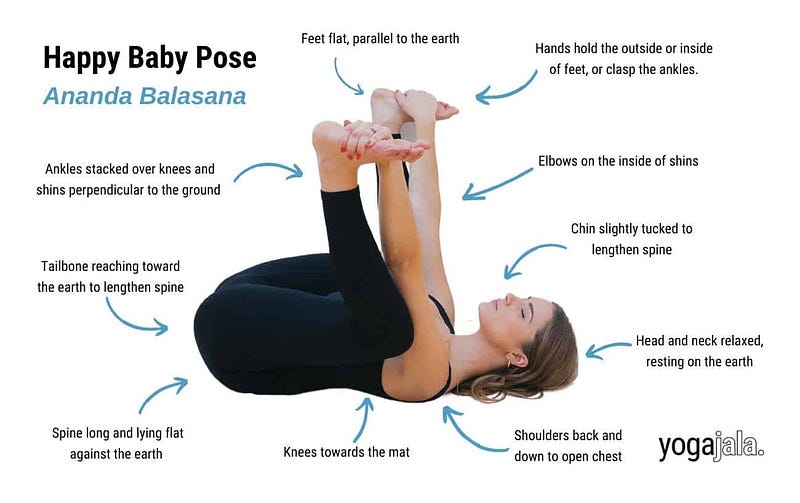
Exercise 4: Half Bridge Pose (Ardha Setu Bandhasana)
When your heart is elevated above your head, the baroreceptor reflex activates, helping regulate blood pressure.
To practice: 1. Lie on your back, bending your knees and bringing your feet close to your hips, keeping them hip-width apart. 2. Place your hands at your sides, palms down. 3. Inhale and press your hands into the floor, lifting your hips toward the ceiling. 4. Hold for five breaths.
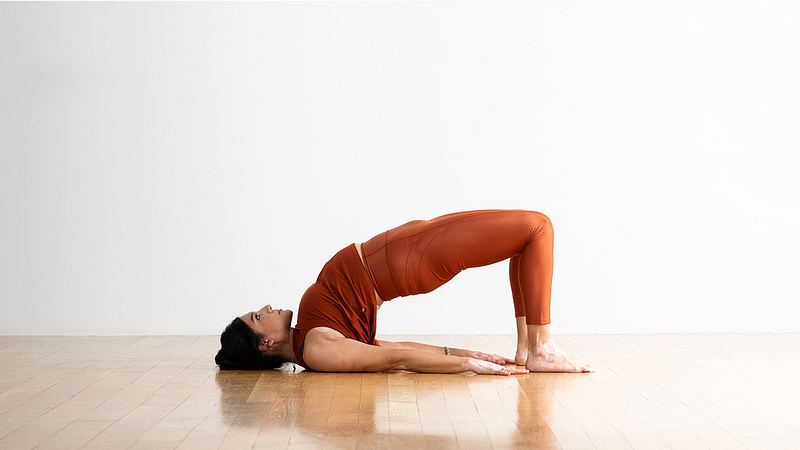
Fun Variation: I enjoy making this pose dynamic by inhaling and lifting my hips, then exhaling and lowering them. Five to ten breaths are usually sufficient.
Exercise 5: Abdominal Massage
Given that the vagus nerve terminates in the gut, this area is an excellent focus.
Start by gently massaging your belly, applying pressure across the organs and digestive tract, increasing the pressure as comfortable.
Benefits of abdominal massage include: - Enhanced digestion - Relief from constipation - Release of physical and emotional tension - Alleviation of PMS discomfort - Stimulation of the vagus nerve
Additional Considerations
The vagus nerve thrives in a calming environment, so creating a distraction-free space will enhance your practice.
I prefer to put away my phone, listen to binaural beats or soothing music, light a candle, and burn incense. Setting an intention can foster deeper relaxation, which is beneficial for the vagus nerve.
Summary
The vagus nerve can be divided into three areas — upper, middle, and lower — each of which can be optimized for better health.
If your vagus nerve is not functioning optimally, unwinding and recovering from stress can be challenging. Use these techniques to strengthen your vagus nerve and promote daily well-being.
Lastly, remember that the vagus nerve appreciates a peaceful atmosphere, so utilize all available methods: - Listen to calming music - Light candles - Burn incense - Wear an eye mask - Disconnect from your phone
Take whatever steps necessary to find tranquility and nurture yourself. Your vagus nerve will express its gratitude in return.
> “The vagus nerve is the hidden key to unlock overall wellness.” > — Sahil Bloom